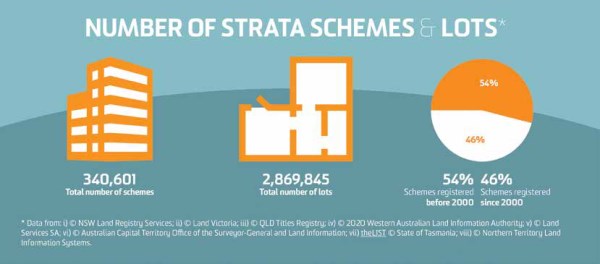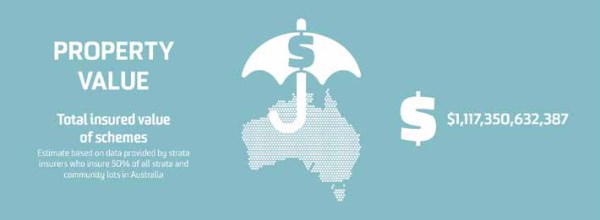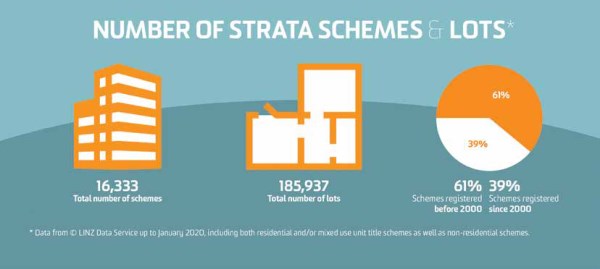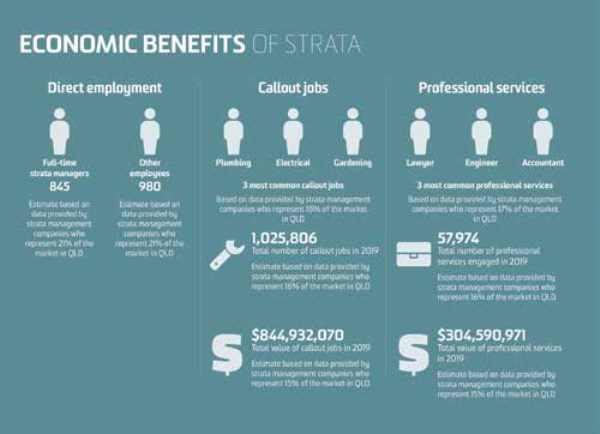Australasian Strata Insights 2020

City Futures Research Centre, Faculty of Built Environment, UNSW Sydney
We recently published the second edition of our report on the strata sector in Australia and can tell you that there are now almost 3 million strata and community title properties in Australia. They are spread across more than 340,000 schemes and have an insured value of over $1.1 trillion. That’s an increase in value of over $100 million just in the past 2 years.
This year, for the first time, we were able to report on the New Zealand strata sector too. Across the ditch there are around 186,000 lots across 16,000 schemes. This places New Zealand somewhere between South Australia (131,622 lots) and WA (251,425 lots) in terms of the size of the sector.
While more than half (59%) of all schemes in New Zealand have less than 5 lots, the proportion in Australia with less than 5 lots is even higher (67%). The bigger end of town is comparatively bigger in New Zealand too, with 24% of all lots being in schemes with over 100 lots, compared to only 10% in Australia. This result is largely thanks to the North Island, where 27% of lots are found in large schemes of 100 lots or more. In comparison, the South Island has a more even spread of lot distribution by scheme size. Unsurprisingly, recent growth is concentrated in Auckland, however the Waikato, Canterbury and Wellington regions also show high numbers of multi-unit dwelling approvals in 2019.

Insured value for Australia

NZ number of lots and schemes and since and after 2000]
The smaller size of the sector in New Zealand is reflected in the estimated population in strata in the two countries. While at least 17% of Australian residents live in strata or community title, the figure is only 6% in New Zealand. In New South Wales, Victoria and the ACT around 20% of people live in strata.
In Australia, growth in attached dwellings continues to be concentrated in New South Wales, Victoria and Queensland. New South Wales currently has the largest number of strata lots (over 960,000), but Victoria has the most schemes (almost 116,000). A whopping 73% of all strata lots in Victoria are in schemes with 5 or fewer lots, which between them contain 26% of all lots in the state. The Australian Capital Territory wins the crown for the jurisdiction with the highest proportion of lots in very large schemes, with 29% of all lots in schemes over 100 lots, and only 9% in smaller schemes under 5 lots.
The jurisdiction with the lowest number of strata properties is the Northern Territory ( just over 25,000 lots), yet 16% of the population live in strata in the Territory. The jurisdiction with the smallest proportion of the population living in strata is the South Island of New Zealand (4%) and in Australia, Tasmania and South Australia are in close contention with around 1 in 10 people living in strata.
Strata Insights also reports on the economic benefits of strata, and estimates based on a sample of strata management companies tell us that that these companies employ around 10,000 people in Australia and 1,000 in New Zealand. Unfortunately, we didn’t get enough data to present the value of callout jobs or professional services nationally in either country this time, but we do have estimates for some states. In Queensland, for example, we estimate there were over one million call out jobs to undertake work on strata schemes in 2019 (such as plumbing, electrical and gardening work) with a total value of over $800 million.
For more insights about strata and community title across Australia and New Zealand, take a look through the Strata Insights Report. In another first this year, as a supplement to the report, we have published an interactive map of strata schemes from the introduction of strata title across Australia and New Zealand. You can zoom in to the suburb level and explore the growth of strata over time.
You will find both the report and the interactive map here: cityfutures.be.unsw.edu.au/research/projects/2020-australasian-strata-insights

QLD economic benefits
View Comments
(0)